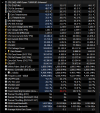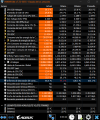76W and not 88W? Thanks for clarification. Because of a wrong assumption I was convinced that CPU PTT value in hwinfo is already recalculated to an actual real value.
Thanks.
UPDATE:
So decided to have a go with 'CPU VDD Full Scale Current' setting. And it turns out that after setting it to 145A in bios the PRD in hwinfo is now very close to 100% under full load in Cinebench and without oc.
Interestingly that has been already pointed out by DrhexUK in post #294 and by u/The-Stilt on reddit.
Very late reply, but might still be of use for similar MSI B450 Boards, as I observed different values for default+adjusted (206->165).
I moved a 5800x B0 to another system with a B450 Tomahawk Max II on E7C02AMS.H63 (last 1.2.0.3c available). While stock SC scores were ok, MT was lowish vs. on a Strix X470-F (CB20 57xx vs 60xx, CB23 147xx vs >155xx), or most online figures. On the Tomahawk, CB20 power deviation reported ~124-125%, and TDC was always the limiting factor stuck at 100% 95A, instead of PPT (that only raised to 136W reported, bellow max stock 142W, EDC at most 131A).
johnydlr, one can check VDD Full Scale Current's default just by setting Auto and then pressing numpad -/+, so the next value that shows will be adjusted relative to the board's default (changing to 205/207 from base 206 on mine). A few other settings behave the same way, then reset if you type Auto.
It seems VDD Full Scale Current adjustment vs default is proportional to the PRD results in this system. This mb's def. was 206A, so (100x206)/125=164.8 and by adjusting it to 165A, immediately moved PRD to 99.X% during CB20. Scores raised to 60xx (also upper 154xx on CB23), both finally within margin of what I'd expect stock.
CPU Tctl/Tdie took a big hit on CB20, from 73ºC to 85ºC max, all the while raising max all core ~4368MHz to ~4.508, then slowly coming down to ~4479 past 80ºC. Most can be blamed on an ancient TRUE Blk Rev.A + 2xNF-A12X25 over the 8C CCD (...and a ~8 y.o. tube of CFIII -- went out of newer paste while mounting). IIRC, previously on the other mb+Galahad 360+fresher case, slightly higher boost figures were under 76ºC. So, I'll have to CO'it while taming MT a bit.
(Btw, an all core -5 CO will lower reported PRD from ~125 to 122% vs stock), so maybe it's better to disable it prior to adjusting PRD)









